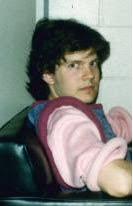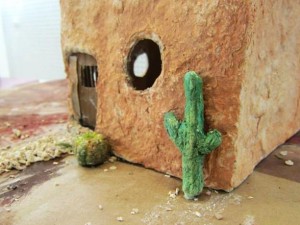By: Becky Larson
 At first glance, I took Mr. Lawton to be funny and a very talented performer. There he was leading his class in a spirited version of “Froggy Went A Courting ” on the recorder. That was him writing a perfectly rhymed, perfectly irreverent, four-part madrigal in honor of the school’s 25th Anniversary. And there he was again doing an uncanny version of Elvis’s “Blue Christmas” while thumping on his stand up bass, all in those imposing dreadlocks.
At first glance, I took Mr. Lawton to be funny and a very talented performer. There he was leading his class in a spirited version of “Froggy Went A Courting ” on the recorder. That was him writing a perfectly rhymed, perfectly irreverent, four-part madrigal in honor of the school’s 25th Anniversary. And there he was again doing an uncanny version of Elvis’s “Blue Christmas” while thumping on his stand up bass, all in those imposing dreadlocks.
He may be a talented performer, trained in voice at the Manhattan School of Music, but Peter Lawton also describes himself as a deeply practical man. He’s worn that signature hair-do for 17 years, because, “I had long hair and my hair is really bushy,” he says. Simple as that.
 His move from public school math teacher to Waldorf class teacher was just as straightforward. When he first encountered Waldorf education, the methods immediately felt useful, and it seemed like a good way to support his children. Over time, he’s encountered increasingly rich layers of meaning.
His move from public school math teacher to Waldorf class teacher was just as straightforward. When he first encountered Waldorf education, the methods immediately felt useful, and it seemed like a good way to support his children. Over time, he’s encountered increasingly rich layers of meaning.
“It’s like an iceberg,” he says. “You can feel the difference, but you can see only the little tip of it there. Under the water, it’s an entire continent.” Like a geologist, he spent years uncovering new aspects of the philosophy, what it brings out in the children and in himself too.
“You keep uncovering it,” he says. “Why it’s built the way it is, why the methods are they way they are, the philosophical system it’s based on- you can never stop uncovering.”
He has discovered deep value in the social aspect of Waldorf education. “A strong group sense is the basis for what we do with the rest of our lives,” he says. “Most of what we want or need, we need this group sense to accomplish. Everything has ripple effects all over, so you have to develop a sense of that through real inner experience of others. You have to develop a sense of how everyone relies on each other.”
The third grade curriculum reinforces this notion of human beings working in connection to each other and their environment. The third grade shelter projects are a clear example of this.
 How does an adobe house reflect it’s desert climate? Would it work in a rainy place? Why did dessert dwelling people build this kind of home? What can a farmhouse tell you about the life of the people and animals living there? Do farms look different in different climates? Why might that be? How can all these different elements- land, plants, animals, people- work together?
How does an adobe house reflect it’s desert climate? Would it work in a rainy place? Why did dessert dwelling people build this kind of home? What can a farmhouse tell you about the life of the people and animals living there? Do farms look different in different climates? Why might that be? How can all these different elements- land, plants, animals, people- work together?
As the third graders use their curiosity to pursue these questions, they discover connections between seemingly disparate things.
“Developing a sense of their identity through the community they are part of is really important. We live in a society that pushes individualism [on children] earlier and earlier, and it leads to these people who can’t work in groups. Unbridled individualism actually works against the individual.”
That’s one reason that every day, the third graders in Mr. Lawton’s class make time to say this verse.
We Are The Third Grade.
We are one class together.
We are one class apart.
We are one class together,
Head, hands and heart.
“To follow your bliss and be free, you have to be able to work with others,” says Mr. Lawton earnestly.
So, what is it like working with the community of teachers and families here at City of Lakes Waldorf School? He feels embraced by Waldorf’s intrinsic appreciation of educators. “This community is very kind and respectful of teachers. It’s great to teach where you are culturally valued,” says Mr. Lawton. The work is a refining process for his development too.
“What you are asked to do, from the man [Steiner] himself, is to become a better person. Working on your stuff, it creates a psychic or spiritual energy flow, because that’s what you’re asking the kids to do.”
There is a simple elegance to this relationship. As every parent knows, children have an incredible sense of authenticity. They know when their teacher is giving their best, and respond accordingly. “This is a job where you are asked to work on yourself- it’s a difficult job because the community is small, and everyone discovers your sore spots, and all the warts, and then what? Can you flex and transform?”
“The anxiety of trying something new is hard, but the transformation is the reward. ” When you rely on the formula, or what you already know, the grind sets in. “Over time, it’s better to stay creative, ” says Lawton. I have no doubt the value of creativity is exactly what Mr. Lawton’s students are learning on their journey through childhood.

